The Story Behind the Photograph
Photographing a Jumping American Toad
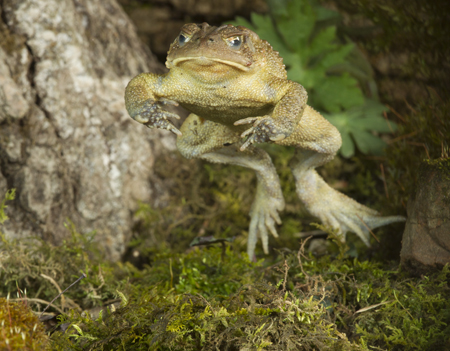
American Toad jumping, shot with a High Speed Shutter
Last month, as the first warm days generated the breeding eruption of wood frogs, I tried the new Cognisys High Speed Shutter. Days later, I was off to Ecuador to photograph hummingbirds, and upon my return the American Toads were now in full courtship mode. Time to try the shutter again!
Although it is possible, I suspect, to set up the equipment and to attempt to photograph a frog or toad in the field, the reality, the probability, of making the type of shot I envisioned, in the field, was nearly impossible. Instead, it is easiest, and most practical, to collect the toad and to do this type of shot in the studio.
This comment, to a canny photographer, might be obvious, but I can imagine some reading this and being disappointed. If you are, try this yourself, in the field, even without the fancy gear. You'll find it virtually impossible. Thus, to capture a unique, exciting image, even a photographer with the best intentions must consider shooting a controlled subject, in studio.
Fortunately, here at Hoot Hollow it is quite easy to find subjects. Although I set up a new, large and shallow pond in one of our fields specifically for American Toads, I never collect a specimen from there. At my pond, the toads are in a sanctuary, and except for natural light, or flash photography at night, the toads are not molested. However, just across the road, my neighbor had done some logging this spring and in tearing up and destroying wonderful habitat, the equipment used for removing logs also created long, shallow ruts that were filled with the spring rains. These ponds wouldn't last, and offered no food for any tadpoles, but the toads don't know this, and many gathered here to call and fruitlessly breed. These are the toads I caught.
In studio I created a simple set that resembled the habitat around my woods. When doing this, the key is to make the set simple but realistic. I've seen many photographers attempt to recreate all the chaos of a forest in a studio set, which might look pretty but generally results in lost animals or tremendous inconvenience. Instead, should you try this, I'd suggest you look at a small area, analyze what comprises the small parts, and just recreate that. For me, that means a bit of dirt, some moss, and a few background rocks or logs, and the setting looks authentic. Perhaps there is an art to this ... but it only takes me minutes.
To get the shot I used the StopShot, the High Speed Shutter, and either the Laser or the Range IR for firing the system. The Laser emits a very narrow visible beam that allows for real precision for triggering the shutter, but since it needs a receiver on the opposite end to 'catch' the laser the alignment has to be perfect. I was having very good results with the Laser until I bumped the rig and lost my alignment and, try as I might, I couldn't get a consistent alignment. Not wanting to keep the toads any longer than I had to, I switched to the Range IR.
The Range IR emits an InfraRed beam, and the unit acts as both a transmitter of the beam and a receiver when something (like a toad) breaks the beam and reflects the IR back to the receiver. InfraRed is invisible, so there's a wee bit more experimentation involved in getting the placement exactly right, but there is no issue of alignment. Usually it only takes me a few minutes to position the beam where I'm hoping the toad will jump.
I had the StopShot configured so that a single sensor (either the Laser or the Range IR) would fire the system. Further, the StopShot controlled my camera's operation, advancing to the next frame if the sensor was tripped, or after a minute of exposure if it was not. I had the camera on Bulb, and the StopShot controlled this advancement and length of exposure.
With a High Speed Shutter you must be on Bulb, as the shutter, which screws into the front of a lens, replaces the camera shutter. Now all my camera shutter does is remain open, waiting for the High Speed Shutter to open, for the flash to fire, and for the shutter to close. Programming the StopShot to advance to the next frame after one minute minimizes or eliminates any noise issues with a digital sensor.
I was using a Canon 70-200mm F4 lens, which has a 67mm front filter thread. The High Speed Shutter's opening is only 30mm, so care must be taken in both the focal length and the aperture you use, otherwise you'll have vignetting. I kept my lens zoomed out to 200mm, and used an aperture of f11-13, and vignetting was not a problem. If you try this you'll need to experiment, as vignetting will vary depending upon the crop factor of your camera, the lens length, and the aperture. Experiment with a static subject, like a sheet of white paper, so that the effects of vignetting (the dark corners or tunnel like view) will be apparent.
Because I had several toads available I'd place an individual on my set for a couple of jumps, then switch to a different toad. Some toads NEVER jumped, they just sat in a cute toad pose. Others jumped this way, then that way, but never the right way! Once in a while, though, I'd find a star, a toad that rather consistently jumped in the right direction and tripped the laser or Range IR and fired the system.
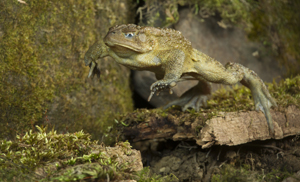 Even then though, sharp focus isn't assured because a toad might trigger the system at an angle, or with a projecting limb. At f11 the depth-of-field is quite narrow, so I had several stunning poses that were, unfortunately, very out-of-focus. To facilitate sharp images, I'd rearrange the set a little bit to create a more obvious jump path, that some toads actually used.
Even then though, sharp focus isn't assured because a toad might trigger the system at an angle, or with a projecting limb. At f11 the depth-of-field is quite narrow, so I had several stunning poses that were, unfortunately, very out-of-focus. To facilitate sharp images, I'd rearrange the set a little bit to create a more obvious jump path, that some toads actually used.
The entire exercise took a full day, as I needed to build the studio set, erect the Manfrotto lightstands and Magic Arms, position my flashes, and arrange the laser or beams. The actual 'shoot' took about four hours, and a lot of patience, dealing with the toads.

However, it was worth the trouble, and, for the toads, a nice pay-off, as I released the toads in my pond where they'd join their mates and, if lucky enough to breed, they would have a perfect breeding pond that would exist throughout the development of the toad's tadpoles.
If you'd like to learn more about this type of photography, I address this type of work in our Advanced Flash Nature Photo Course – if you are interested in this, please contact the office. In that course I'll be covering TTL and Manual flash, and perhaps more importantly, I'll be demonstrating and teaching techniques with the Range IR and you'll be using this equipment in the projects I'll be assigning you. In our Reptile Photo Shoot we photograph scores of different species, but, unfortunately, time and logistics prevents me from doing an elaborate action sequence like this.
The basics of all this flash information will be covered in our Digital Complete Nature Photo Course as well, but not in the depth of the Advanced course. Nonetheless, the DCNPC would get you started.
Past Stories Behind the Photograph
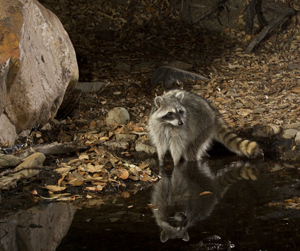
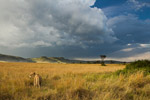

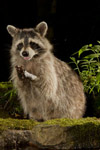
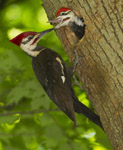


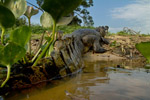
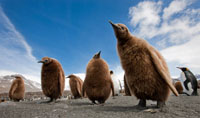
.jpg)

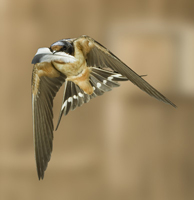
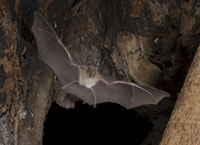

The Ocelot
The Waterhole
Bushbaby
Barn Swallow
King Penguin
The Lion and the Landscape
The Bighorn Sheep
The Raccoon
The Pileated Woodpecker
The Striking Rattlesnake
The Pink Salmon
The Spectacled Caimen
Check out our latest web site,
mcdonaldwildlifephotos.com
where we'll be adding portfolios and eventually building up
a searchable data base for photo buyers. We've just started,
and the selection is limited, but it is still worth a visit!
Office Phone: (717) 543-6423
Or FAX us at: (717) 543-5342
The Story Behind the Photograph
Photographing a Jumping American Toad

American Toad jumping, shot with a High Speed Shutter
Last month, as the first warm days generated the breeding eruption of wood frogs, I tried the new Cognisys High Speed Shutter. Days later, I was off to Ecuador to photograph hummingbirds, and upon my return the American Toads were now in full courtship mode. Time to try the shutter again!
Although it is possible, I suspect, to set up the equipment and to attempt to photograph a frog or toad in the field, the reality, the probability, of making the type of shot I envisioned, in the field, was nearly impossible. Instead, it is easiest, and most practical, to collect the toad and to do this type of shot in the studio.
This comment, to a canny photographer, might be obvious, but I can imagine some reading this and being disappointed. If you are, try this yourself, in the field, even without the fancy gear. You'll find it virtually impossible. Thus, to capture a unique, exciting image, even a photographer with the best intentions must consider shooting a controlled subject, in studio.
Fortunately, here at Hoot Hollow it is quite easy to find subjects. Although I set up a new, large and shallow pond in one of our fields specifically for American Toads, I never collect a specimen from there. At my pond, the toads are in a sanctuary, and except for natural light, or flash photography at night, the toads are not molested. However, just across the road, my neighbor had done some logging this spring and in tearing up and destroying wonderful habitat, the equipment used for removing logs also created long, shallow ruts that were filled with the spring rains. These ponds wouldn't last, and offered no food for any tadpoles, but the toads don't know this, and many gathered here to call and fruitlessly breed. These are the toads I caught.
In studio I created a simple set that resembled the habitat around my woods. When doing this, the key is to make the set simple but realistic. I've seen many photographers attempt to recreate all the chaos of a forest in a studio set, which might look pretty but generally results in lost animals or tremendous inconvenience. Instead, should you try this, I'd suggest you look at a small area, analyze what comprises the small parts, and just recreate that. For me, that means a bit of dirt, some moss, and a few background rocks or logs, and the setting looks authentic. Perhaps there is an art to this ... but it only takes me minutes.
To get the shot I used the StopShot, the High Speed Shutter, and either the Laser or the Range IR for firing the system. The Laser emits a very narrow visible beam that allows for real precision for triggering the shutter, but since it needs a receiver on the opposite end to 'catch' the laser the alignment has to be perfect. I was having very good results with the Laser until I bumped the rig and lost my alignment and, try as I might, I couldn't get a consistent alignment. Not wanting to keep the toads any longer than I had to, I switched to the Range IR.
The Range IR emits an InfraRed beam, and the unit acts as both a transmitter of the beam and a receiver when something (like a toad) breaks the beam and reflects the IR back to the receiver. InfraRed is invisible, so there's a wee bit more experimentation involved in getting the placement exactly right, but there is no issue of alignment. Usually it only takes me a few minutes to position the beam where I'm hoping the toad will jump.
I had the StopShot configured so that a single sensor (either the Laser or the Range IR) would fire the system. Further, the StopShot controlled my camera's operation, advancing to the next frame if the sensor was tripped, or after a minute of exposure if it was not. I had the camera on Bulb, and the StopShot controlled this advancement and length of exposure.
With a High Speed Shutter you must be on Bulb, as the shutter, which screws into the front of a lens, replaces the camera shutter. Now all my camera shutter does is remain open, waiting for the High Speed Shutter to open, for the flash to fire, and for the shutter to close. Programming the StopShot to advance to the next frame after one minute minimizes or eliminates any noise issues with a digital sensor.
I was using a Canon 70-200mm F4 lens, which has a 67mm front filter thread. The High Speed Shutter's opening is only 30mm, so care must be taken in both the focal length and the aperture you use, otherwise you'll have vignetting. I kept my lens zoomed out to 200mm, and used an aperture of f11-13, and vignetting was not a problem. If you try this you'll need to experiment, as vignetting will vary depending upon the crop factor of your camera, the lens length, and the aperture. Experiment with a static subject, like a sheet of white paper, so that the effects of vignetting (the dark corners or tunnel like view) will be apparent.
Because I had several toads available I'd place an individual on my set for a couple of jumps, then switch to a different toad. Some toads NEVER jumped, they just sat in a cute toad pose. Others jumped this way, then that way, but never the right way! Once in a while, though, I'd find a star, a toad that rather consistently jumped in the right direction and tripped the laser or Range IR and fired the system.
 Even then though, sharp focus isn't assured because a toad might trigger the system at an angle, or with a projecting limb. At f11 the depth-of-field is quite narrow, so I had several stunning poses that were, unfortunately, very out-of-focus. To facilitate sharp images, I'd rearrange the set a little bit to create a more obvious jump path, that some toads actually used.
Even then though, sharp focus isn't assured because a toad might trigger the system at an angle, or with a projecting limb. At f11 the depth-of-field is quite narrow, so I had several stunning poses that were, unfortunately, very out-of-focus. To facilitate sharp images, I'd rearrange the set a little bit to create a more obvious jump path, that some toads actually used.
The entire exercise took a full day, as I needed to build the studio set, erect the Manfrotto lightstands and Magic Arms, position my flashes, and arrange the laser or beams. The actual 'shoot' took about four hours, and a lot of patience, dealing with the toads.

However, it was worth the trouble, and, for the toads, a nice pay-off, as I released the toads in my pond where they'd join their mates and, if lucky enough to breed, they would have a perfect breeding pond that would exist throughout the development of the toad's tadpoles.
If you'd like to learn more about this type of photography, I address this type of work in our Advanced Flash Nature Photo Course – if you are interested in this, please contact the office. In that course I'll be covering TTL and Manual flash, and perhaps more importantly, I'll be demonstrating and teaching techniques with the Range IR and you'll be using this equipment in the projects I'll be assigning you. In our Reptile Photo Shoot we photograph scores of different species, but, unfortunately, time and logistics prevents me from doing an elaborate action sequence like this.
The basics of all this flash information will be covered in our Digital Complete Nature Photo Course as well, but not in the depth of the Advanced course. Nonetheless, the DCNPC would get you started.
The Story Behind the Photograph
Photographing a Jumping American Toad

American Toad jumping, shot with a High Speed Shutter
Last month, as the first warm days generated the breeding eruption of wood frogs, I tried the new Cognisys High Speed Shutter. Days later, I was off to Ecuador to photograph hummingbirds, and upon my return the American Toads were now in full courtship mode. Time to try the shutter again!
Although it is possible, I suspect, to set up the equipment and to attempt to photograph a frog or toad in the field, the reality, the probability, of making the type of shot I envisioned, in the field, was nearly impossible. Instead, it is easiest, and most practical, to collect the toad and to do this type of shot in the studio.
This comment, to a canny photographer, might be obvious, but I can imagine some reading this and being disappointed. If you are, try this yourself, in the field, even without the fancy gear. You'll find it virtually impossible. Thus, to capture a unique, exciting image, even a photographer with the best intentions must consider shooting a controlled subject, in studio.
Fortunately, here at Hoot Hollow it is quite easy to find subjects. Although I set up a new, large and shallow pond in one of our fields specifically for American Toads, I never collect a specimen from there. At my pond, the toads are in a sanctuary, and except for natural light, or flash photography at night, the toads are not molested. However, just across the road, my neighbor had done some logging this spring and in tearing up and destroying wonderful habitat, the equipment used for removing logs also created long, shallow ruts that were filled with the spring rains. These ponds wouldn't last, and offered no food for any tadpoles, but the toads don't know this, and many gathered here to call and fruitlessly breed. These are the toads I caught.
In studio I created a simple set that resembled the habitat around my woods. When doing this, the key is to make the set simple but realistic. I've seen many photographers attempt to recreate all the chaos of a forest in a studio set, which might look pretty but generally results in lost animals or tremendous inconvenience. Instead, should you try this, I'd suggest you look at a small area, analyze what comprises the small parts, and just recreate that. For me, that means a bit of dirt, some moss, and a few background rocks or logs, and the setting looks authentic. Perhaps there is an art to this ... but it only takes me minutes.
To get the shot I used the StopShot, the High Speed Shutter, and either the Laser or the Range IR for firing the system. The Laser emits a very narrow visible beam that allows for real precision for triggering the shutter, but since it needs a receiver on the opposite end to 'catch' the laser the alignment has to be perfect. I was having very good results with the Laser until I bumped the rig and lost my alignment and, try as I might, I couldn't get a consistent alignment. Not wanting to keep the toads any longer than I had to, I switched to the Range IR.
The Range IR emits an InfraRed beam, and the unit acts as both a transmitter of the beam and a receiver when something (like a toad) breaks the beam and reflects the IR back to the receiver. InfraRed is invisible, so there's a wee bit more experimentation involved in getting the placement exactly right, but there is no issue of alignment. Usually it only takes me a few minutes to position the beam where I'm hoping the toad will jump.
I had the StopShot configured so that a single sensor (either the Laser or the Range IR) would fire the system. Further, the StopShot controlled my camera's operation, advancing to the next frame if the sensor was tripped, or after a minute of exposure if it was not. I had the camera on Bulb, and the StopShot controlled this advancement and length of exposure.
With a High Speed Shutter you must be on Bulb, as the shutter, which screws into the front of a lens, replaces the camera shutter. Now all my camera shutter does is remain open, waiting for the High Speed Shutter to open, for the flash to fire, and for the shutter to close. Programming the StopShot to advance to the next frame after one minute minimizes or eliminates any noise issues with a digital sensor.
I was using a Canon 70-200mm F4 lens, which has a 67mm front filter thread. The High Speed Shutter's opening is only 30mm, so care must be taken in both the focal length and the aperture you use, otherwise you'll have vignetting. I kept my lens zoomed out to 200mm, and used an aperture of f11-13, and vignetting was not a problem. If you try this you'll need to experiment, as vignetting will vary depending upon the crop factor of your camera, the lens length, and the aperture. Experiment with a static subject, like a sheet of white paper, so that the effects of vignetting (the dark corners or tunnel like view) will be apparent.
Because I had several toads available I'd place an individual on my set for a couple of jumps, then switch to a different toad. Some toads NEVER jumped, they just sat in a cute toad pose. Others jumped this way, then that way, but never the right way! Once in a while, though, I'd find a star, a toad that rather consistently jumped in the right direction and tripped the laser or Range IR and fired the system.
 Even then though, sharp focus isn't assured because a toad might trigger the system at an angle, or with a projecting limb. At f11 the depth-of-field is quite narrow, so I had several stunning poses that were, unfortunately, very out-of-focus. To facilitate sharp images, I'd rearrange the set a little bit to create a more obvious jump path, that some toads actually used.
Even then though, sharp focus isn't assured because a toad might trigger the system at an angle, or with a projecting limb. At f11 the depth-of-field is quite narrow, so I had several stunning poses that were, unfortunately, very out-of-focus. To facilitate sharp images, I'd rearrange the set a little bit to create a more obvious jump path, that some toads actually used.
The entire exercise took a full day, as I needed to build the studio set, erect the Manfrotto lightstands and Magic Arms, position my flashes, and arrange the laser or beams. The actual 'shoot' took about four hours, and a lot of patience, dealing with the toads.

However, it was worth the trouble, and, for the toads, a nice pay-off, as I released the toads in my pond where they'd join their mates and, if lucky enough to breed, they would have a perfect breeding pond that would exist throughout the development of the toad's tadpoles.
If you'd like to learn more about this type of photography, I address this type of work in our Advanced Flash Nature Photo Course – if you are interested in this, please contact the office. In that course I'll be covering TTL and Manual flash, and perhaps more importantly, I'll be demonstrating and teaching techniques with the Range IR and you'll be using this equipment in the projects I'll be assigning you. In our Reptile Photo Shoot we photograph scores of different species, but, unfortunately, time and logistics prevents me from doing an elaborate action sequence like this.
The basics of all this flash information will be covered in our Digital Complete Nature Photo Course as well, but not in the depth of the Advanced course. Nonetheless, the DCNPC would get you started.
The Story Behind the Photograph
Photographing a Jumping American Toad

American Toad jumping, shot with a High Speed Shutter
Last month, as the first warm days generated the breeding eruption of wood frogs, I tried the new Cognisys High Speed Shutter. Days later, I was off to Ecuador to photograph hummingbirds, and upon my return the American Toads were now in full courtship mode. Time to try the shutter again!
Although it is possible, I suspect, to set up the equipment and to attempt to photograph a frog or toad in the field, the reality, the probability, of making the type of shot I envisioned, in the field, was nearly impossible. Instead, it is easiest, and most practical, to collect the toad and to do this type of shot in the studio.
This comment, to a canny photographer, might be obvious, but I can imagine some reading this and being disappointed. If you are, try this yourself, in the field, even without the fancy gear. You'll find it virtually impossible. Thus, to capture a unique, exciting image, even a photographer with the best intentions must consider shooting a controlled subject, in studio.
Fortunately, here at Hoot Hollow it is quite easy to find subjects. Although I set up a new, large and shallow pond in one of our fields specifically for American Toads, I never collect a specimen from there. At my pond, the toads are in a sanctuary, and except for natural light, or flash photography at night, the toads are not molested. However, just across the road, my neighbor had done some logging this spring and in tearing up and destroying wonderful habitat, the equipment used for removing logs also created long, shallow ruts that were filled with the spring rains. These ponds wouldn't last, and offered no food for any tadpoles, but the toads don't know this, and many gathered here to call and fruitlessly breed. These are the toads I caught.
In studio I created a simple set that resembled the habitat around my woods. When doing this, the key is to make the set simple but realistic. I've seen many photographers attempt to recreate all the chaos of a forest in a studio set, which might look pretty but generally results in lost animals or tremendous inconvenience. Instead, should you try this, I'd suggest you look at a small area, analyze what comprises the small parts, and just recreate that. For me, that means a bit of dirt, some moss, and a few background rocks or logs, and the setting looks authentic. Perhaps there is an art to this ... but it only takes me minutes.
To get the shot I used the StopShot, the High Speed Shutter, and either the Laser or the Range IR for firing the system. The Laser emits a very narrow visible beam that allows for real precision for triggering the shutter, but since it needs a receiver on the opposite end to 'catch' the laser the alignment has to be perfect. I was having very good results with the Laser until I bumped the rig and lost my alignment and, try as I might, I couldn't get a consistent alignment. Not wanting to keep the toads any longer than I had to, I switched to the Range IR.
The Range IR emits an InfraRed beam, and the unit acts as both a transmitter of the beam and a receiver when something (like a toad) breaks the beam and reflects the IR back to the receiver. InfraRed is invisible, so there's a wee bit more experimentation involved in getting the placement exactly right, but there is no issue of alignment. Usually it only takes me a few minutes to position the beam where I'm hoping the toad will jump.
I had the StopShot configured so that a single sensor (either the Laser or the Range IR) would fire the system. Further, the StopShot controlled my camera's operation, advancing to the next frame if the sensor was tripped, or after a minute of exposure if it was not. I had the camera on Bulb, and the StopShot controlled this advancement and length of exposure.
With a High Speed Shutter you must be on Bulb, as the shutter, which screws into the front of a lens, replaces the camera shutter. Now all my camera shutter does is remain open, waiting for the High Speed Shutter to open, for the flash to fire, and for the shutter to close. Programming the StopShot to advance to the next frame after one minute minimizes or eliminates any noise issues with a digital sensor.
I was using a Canon 70-200mm F4 lens, which has a 67mm front filter thread. The High Speed Shutter's opening is only 30mm, so care must be taken in both the focal length and the aperture you use, otherwise you'll have vignetting. I kept my lens zoomed out to 200mm, and used an aperture of f11-13, and vignetting was not a problem. If you try this you'll need to experiment, as vignetting will vary depending upon the crop factor of your camera, the lens length, and the aperture. Experiment with a static subject, like a sheet of white paper, so that the effects of vignetting (the dark corners or tunnel like view) will be apparent.
Because I had several toads available I'd place an individual on my set for a couple of jumps, then switch to a different toad. Some toads NEVER jumped, they just sat in a cute toad pose. Others jumped this way, then that way, but never the right way! Once in a while, though, I'd find a star, a toad that rather consistently jumped in the right direction and tripped the laser or Range IR and fired the system.
 Even then though, sharp focus isn't assured because a toad might trigger the system at an angle, or with a projecting limb. At f11 the depth-of-field is quite narrow, so I had several stunning poses that were, unfortunately, very out-of-focus. To facilitate sharp images, I'd rearrange the set a little bit to create a more obvious jump path, that some toads actually used.
Even then though, sharp focus isn't assured because a toad might trigger the system at an angle, or with a projecting limb. At f11 the depth-of-field is quite narrow, so I had several stunning poses that were, unfortunately, very out-of-focus. To facilitate sharp images, I'd rearrange the set a little bit to create a more obvious jump path, that some toads actually used.
The entire exercise took a full day, as I needed to build the studio set, erect the Manfrotto lightstands and Magic Arms, position my flashes, and arrange the laser or beams. The actual 'shoot' took about four hours, and a lot of patience, dealing with the toads.

However, it was worth the trouble, and, for the toads, a nice pay-off, as I released the toads in my pond where they'd join their mates and, if lucky enough to breed, they would have a perfect breeding pond that would exist throughout the development of the toad's tadpoles.
If you'd like to learn more about this type of photography, I address this type of work in our Advanced Flash Nature Photo Course – if you are interested in this, please contact the office. In that course I'll be covering TTL and Manual flash, and perhaps more importantly, I'll be demonstrating and teaching techniques with the Range IR and you'll be using this equipment in the projects I'll be assigning you. In our Reptile Photo Shoot we photograph scores of different species, but, unfortunately, time and logistics prevents me from doing an elaborate action sequence like this.
The basics of all this flash information will be covered in our Digital Complete Nature Photo Course as well, but not in the depth of the Advanced course. Nonetheless, the DCNPC would get you started.
The Story Behind the Photograph
Photographing a Jumping American Toad

American Toad jumping, shot with a High Speed Shutter
Last month, as the first warm days generated the breeding eruption of wood frogs, I tried the new Cognisys High Speed Shutter. Days later, I was off to Ecuador to photograph hummingbirds, and upon my return the American Toads were now in full courtship mode. Time to try the shutter again!
Although it is possible, I suspect, to set up the equipment and to attempt to photograph a frog or toad in the field, the reality, the probability, of making the type of shot I envisioned, in the field, was nearly impossible. Instead, it is easiest, and most practical, to collect the toad and to do this type of shot in the studio.
This comment, to a canny photographer, might be obvious, but I can imagine some reading this and being disappointed. If you are, try this yourself, in the field, even without the fancy gear. You'll find it virtually impossible. Thus, to capture a unique, exciting image, even a photographer with the best intentions must consider shooting a controlled subject, in studio.
Fortunately, here at Hoot Hollow it is quite easy to find subjects. Although I set up a new, large and shallow pond in one of our fields specifically for American Toads, I never collect a specimen from there. At my pond, the toads are in a sanctuary, and except for natural light, or flash photography at night, the toads are not molested. However, just across the road, my neighbor had done some logging this spring and in tearing up and destroying wonderful habitat, the equipment used for removing logs also created long, shallow ruts that were filled with the spring rains. These ponds wouldn't last, and offered no food for any tadpoles, but the toads don't know this, and many gathered here to call and fruitlessly breed. These are the toads I caught.
In studio I created a simple set that resembled the habitat around my woods. When doing this, the key is to make the set simple but realistic. I've seen many photographers attempt to recreate all the chaos of a forest in a studio set, which might look pretty but generally results in lost animals or tremendous inconvenience. Instead, should you try this, I'd suggest you look at a small area, analyze what comprises the small parts, and just recreate that. For me, that means a bit of dirt, some moss, and a few background rocks or logs, and the setting looks authentic. Perhaps there is an art to this ... but it only takes me minutes.
To get the shot I used the StopShot, the High Speed Shutter, and either the Laser or the Range IR for firing the system. The Laser emits a very narrow visible beam that allows for real precision for triggering the shutter, but since it needs a receiver on the opposite end to 'catch' the laser the alignment has to be perfect. I was having very good results with the Laser until I bumped the rig and lost my alignment and, try as I might, I couldn't get a consistent alignment. Not wanting to keep the toads any longer than I had to, I switched to the Range IR.
The Range IR emits an InfraRed beam, and the unit acts as both a transmitter of the beam and a receiver when something (like a toad) breaks the beam and reflects the IR back to the receiver. InfraRed is invisible, so there's a wee bit more experimentation involved in getting the placement exactly right, but there is no issue of alignment. Usually it only takes me a few minutes to position the beam where I'm hoping the toad will jump.
I had the StopShot configured so that a single sensor (either the Laser or the Range IR) would fire the system. Further, the StopShot controlled my camera's operation, advancing to the next frame if the sensor was tripped, or after a minute of exposure if it was not. I had the camera on Bulb, and the StopShot controlled this advancement and length of exposure.
With a High Speed Shutter you must be on Bulb, as the shutter, which screws into the front of a lens, replaces the camera shutter. Now all my camera shutter does is remain open, waiting for the High Speed Shutter to open, for the flash to fire, and for the shutter to close. Programming the StopShot to advance to the next frame after one minute minimizes or eliminates any noise issues with a digital sensor.
I was using a Canon 70-200mm F4 lens, which has a 67mm front filter thread. The High Speed Shutter's opening is only 30mm, so care must be taken in both the focal length and the aperture you use, otherwise you'll have vignetting. I kept my lens zoomed out to 200mm, and used an aperture of f11-13, and vignetting was not a problem. If you try this you'll need to experiment, as vignetting will vary depending upon the crop factor of your camera, the lens length, and the aperture. Experiment with a static subject, like a sheet of white paper, so that the effects of vignetting (the dark corners or tunnel like view) will be apparent.
Because I had several toads available I'd place an individual on my set for a couple of jumps, then switch to a different toad. Some toads NEVER jumped, they just sat in a cute toad pose. Others jumped this way, then that way, but never the right way! Once in a while, though, I'd find a star, a toad that rather consistently jumped in the right direction and tripped the laser or Range IR and fired the system.
 Even then though, sharp focus isn't assured because a toad might trigger the system at an angle, or with a projecting limb. At f11 the depth-of-field is quite narrow, so I had several stunning poses that were, unfortunately, very out-of-focus. To facilitate sharp images, I'd rearrange the set a little bit to create a more obvious jump path, that some toads actually used.
Even then though, sharp focus isn't assured because a toad might trigger the system at an angle, or with a projecting limb. At f11 the depth-of-field is quite narrow, so I had several stunning poses that were, unfortunately, very out-of-focus. To facilitate sharp images, I'd rearrange the set a little bit to create a more obvious jump path, that some toads actually used.
The entire exercise took a full day, as I needed to build the studio set, erect the Manfrotto lightstands and Magic Arms, position my flashes, and arrange the laser or beams. The actual 'shoot' took about four hours, and a lot of patience, dealing with the toads.

However, it was worth the trouble, and, for the toads, a nice pay-off, as I released the toads in my pond where they'd join their mates and, if lucky enough to breed, they would have a perfect breeding pond that would exist throughout the development of the toad's tadpoles.
If you'd like to learn more about this type of photography, I address this type of work in our Advanced Flash Nature Photo Course – if you are interested in this, please contact the office. In that course I'll be covering TTL and Manual flash, and perhaps more importantly, I'll be demonstrating and teaching techniques with the Range IR and you'll be using this equipment in the projects I'll be assigning you. In our Reptile Photo Shoot we photograph scores of different species, but, unfortunately, time and logistics prevents me from doing an elaborate action sequence like this.
The basics of all this flash information will be covered in our Digital Complete Nature Photo Course as well, but not in the depth of the Advanced course. Nonetheless, the DCNPC would get you started.
The Story Behind the Photograph
Photographing a Jumping American Toad

American Toad jumping, shot with a High Speed Shutter
Last month, as the first warm days generated the breeding eruption of wood frogs, I tried the new Cognisys High Speed Shutter. Days later, I was off to Ecuador to photograph hummingbirds, and upon my return the American Toads were now in full courtship mode. Time to try the shutter again!
Although it is possible, I suspect, to set up the equipment and to attempt to photograph a frog or toad in the field, the reality, the probability, of making the type of shot I envisioned, in the field, was nearly impossible. Instead, it is easiest, and most practical, to collect the toad and to do this type of shot in the studio.
This comment, to a canny photographer, might be obvious, but I can imagine some reading this and being disappointed. If you are, try this yourself, in the field, even without the fancy gear. You'll find it virtually impossible. Thus, to capture a unique, exciting image, even a photographer with the best intentions must consider shooting a controlled subject, in studio.
Fortunately, here at Hoot Hollow it is quite easy to find subjects. Although I set up a new, large and shallow pond in one of our fields specifically for American Toads, I never collect a specimen from there. At my pond, the toads are in a sanctuary, and except for natural light, or flash photography at night, the toads are not molested. However, just across the road, my neighbor had done some logging this spring and in tearing up and destroying wonderful habitat, the equipment used for removing logs also created long, shallow ruts that were filled with the spring rains. These ponds wouldn't last, and offered no food for any tadpoles, but the toads don't know this, and many gathered here to call and fruitlessly breed. These are the toads I caught.
In studio I created a simple set that resembled the habitat around my woods. When doing this, the key is to make the set simple but realistic. I've seen many photographers attempt to recreate all the chaos of a forest in a studio set, which might look pretty but generally results in lost animals or tremendous inconvenience. Instead, should you try this, I'd suggest you look at a small area, analyze what comprises the small parts, and just recreate that. For me, that means a bit of dirt, some moss, and a few background rocks or logs, and the setting looks authentic. Perhaps there is an art to this ... but it only takes me minutes.
To get the shot I used the StopShot, the High Speed Shutter, and either the Laser or the Range IR for firing the system. The Laser emits a very narrow visible beam that allows for real precision for triggering the shutter, but since it needs a receiver on the opposite end to 'catch' the laser the alignment has to be perfect. I was having very good results with the Laser until I bumped the rig and lost my alignment and, try as I might, I couldn't get a consistent alignment. Not wanting to keep the toads any longer than I had to, I switched to the Range IR.
The Range IR emits an InfraRed beam, and the unit acts as both a transmitter of the beam and a receiver when something (like a toad) breaks the beam and reflects the IR back to the receiver. InfraRed is invisible, so there's a wee bit more experimentation involved in getting the placement exactly right, but there is no issue of alignment. Usually it only takes me a few minutes to position the beam where I'm hoping the toad will jump.
I had the StopShot configured so that a single sensor (either the Laser or the Range IR) would fire the system. Further, the StopShot controlled my camera's operation, advancing to the next frame if the sensor was tripped, or after a minute of exposure if it was not. I had the camera on Bulb, and the StopShot controlled this advancement and length of exposure.
With a High Speed Shutter you must be on Bulb, as the shutter, which screws into the front of a lens, replaces the camera shutter. Now all my camera shutter does is remain open, waiting for the High Speed Shutter to open, for the flash to fire, and for the shutter to close. Programming the StopShot to advance to the next frame after one minute minimizes or eliminates any noise issues with a digital sensor.
I was using a Canon 70-200mm F4 lens, which has a 67mm front filter thread. The High Speed Shutter's opening is only 30mm, so care must be taken in both the focal length and the aperture you use, otherwise you'll have vignetting. I kept my lens zoomed out to 200mm, and used an aperture of f11-13, and vignetting was not a problem. If you try this you'll need to experiment, as vignetting will vary depending upon the crop factor of your camera, the lens length, and the aperture. Experiment with a static subject, like a sheet of white paper, so that the effects of vignetting (the dark corners or tunnel like view) will be apparent.
Because I had several toads available I'd place an individual on my set for a couple of jumps, then switch to a different toad. Some toads NEVER jumped, they just sat in a cute toad pose. Others jumped this way, then that way, but never the right way! Once in a while, though, I'd find a star, a toad that rather consistently jumped in the right direction and tripped the laser or Range IR and fired the system.
 Even then though, sharp focus isn't assured because a toad might trigger the system at an angle, or with a projecting limb. At f11 the depth-of-field is quite narrow, so I had several stunning poses that were, unfortunately, very out-of-focus. To facilitate sharp images, I'd rearrange the set a little bit to create a more obvious jump path, that some toads actually used.
Even then though, sharp focus isn't assured because a toad might trigger the system at an angle, or with a projecting limb. At f11 the depth-of-field is quite narrow, so I had several stunning poses that were, unfortunately, very out-of-focus. To facilitate sharp images, I'd rearrange the set a little bit to create a more obvious jump path, that some toads actually used.
The entire exercise took a full day, as I needed to build the studio set, erect the Manfrotto lightstands and Magic Arms, position my flashes, and arrange the laser or beams. The actual 'shoot' took about four hours, and a lot of patience, dealing with the toads.

However, it was worth the trouble, and, for the toads, a nice pay-off, as I released the toads in my pond where they'd join their mates and, if lucky enough to breed, they would have a perfect breeding pond that would exist throughout the development of the toad's tadpoles.
If you'd like to learn more about this type of photography, I address this type of work in our Advanced Flash Nature Photo Course – if you are interested in this, please contact the office. In that course I'll be covering TTL and Manual flash, and perhaps more importantly, I'll be demonstrating and teaching techniques with the Range IR and you'll be using this equipment in the projects I'll be assigning you. In our Reptile Photo Shoot we photograph scores of different species, but, unfortunately, time and logistics prevents me from doing an elaborate action sequence like this.
The basics of all this flash information will be covered in our Digital Complete Nature Photo Course as well, but not in the depth of the Advanced course. Nonetheless, the DCNPC would get you started.
The Story Behind the Photograph
Photographing a Jumping American Toad

American Toad jumping, shot with a High Speed Shutter
Last month, as the first warm days generated the breeding eruption of wood frogs, I tried the new Cognisys High Speed Shutter. Days later, I was off to Ecuador to photograph hummingbirds, and upon my return the American Toads were now in full courtship mode. Time to try the shutter again!
Although it is possible, I suspect, to set up the equipment and to attempt to photograph a frog or toad in the field, the reality, the probability, of making the type of shot I envisioned, in the field, was nearly impossible. Instead, it is easiest, and most practical, to collect the toad and to do this type of shot in the studio.
This comment, to a canny photographer, might be obvious, but I can imagine some reading this and being disappointed. If you are, try this yourself, in the field, even without the fancy gear. You'll find it virtually impossible. Thus, to capture a unique, exciting image, even a photographer with the best intentions must consider shooting a controlled subject, in studio.
Fortunately, here at Hoot Hollow it is quite easy to find subjects. Although I set up a new, large and shallow pond in one of our fields specifically for American Toads, I never collect a specimen from there. At my pond, the toads are in a sanctuary, and except for natural light, or flash photography at night, the toads are not molested. However, just across the road, my neighbor had done some logging this spring and in tearing up and destroying wonderful habitat, the equipment used for removing logs also created long, shallow ruts that were filled with the spring rains. These ponds wouldn't last, and offered no food for any tadpoles, but the toads don't know this, and many gathered here to call and fruitlessly breed. These are the toads I caught.
In studio I created a simple set that resembled the habitat around my woods. When doing this, the key is to make the set simple but realistic. I've seen many photographers attempt to recreate all the chaos of a forest in a studio set, which might look pretty but generally results in lost animals or tremendous inconvenience. Instead, should you try this, I'd suggest you look at a small area, analyze what comprises the small parts, and just recreate that. For me, that means a bit of dirt, some moss, and a few background rocks or logs, and the setting looks authentic. Perhaps there is an art to this ... but it only takes me minutes.
To get the shot I used the StopShot, the High Speed Shutter, and either the Laser or the Range IR for firing the system. The Laser emits a very narrow visible beam that allows for real precision for triggering the shutter, but since it needs a receiver on the opposite end to 'catch' the laser the alignment has to be perfect. I was having very good results with the Laser until I bumped the rig and lost my alignment and, try as I might, I couldn't get a consistent alignment. Not wanting to keep the toads any longer than I had to, I switched to the Range IR.
The Range IR emits an InfraRed beam, and the unit acts as both a transmitter of the beam and a receiver when something (like a toad) breaks the beam and reflects the IR back to the receiver. InfraRed is invisible, so there's a wee bit more experimentation involved in getting the placement exactly right, but there is no issue of alignment. Usually it only takes me a few minutes to position the beam where I'm hoping the toad will jump.
I had the StopShot configured so that a single sensor (either the Laser or the Range IR) would fire the system. Further, the StopShot controlled my camera's operation, advancing to the next frame if the sensor was tripped, or after a minute of exposure if it was not. I had the camera on Bulb, and the StopShot controlled this advancement and length of exposure.
With a High Speed Shutter you must be on Bulb, as the shutter, which screws into the front of a lens, replaces the camera shutter. Now all my camera shutter does is remain open, waiting for the High Speed Shutter to open, for the flash to fire, and for the shutter to close. Programming the StopShot to advance to the next frame after one minute minimizes or eliminates any noise issues with a digital sensor.
I was using a Canon 70-200mm F4 lens, which has a 67mm front filter thread. The High Speed Shutter's opening is only 30mm, so care must be taken in both the focal length and the aperture you use, otherwise you'll have vignetting. I kept my lens zoomed out to 200mm, and used an aperture of f11-13, and vignetting was not a problem. If you try this you'll need to experiment, as vignetting will vary depending upon the crop factor of your camera, the lens length, and the aperture. Experiment with a static subject, like a sheet of white paper, so that the effects of vignetting (the dark corners or tunnel like view) will be apparent.
Because I had several toads available I'd place an individual on my set for a couple of jumps, then switch to a different toad. Some toads NEVER jumped, they just sat in a cute toad pose. Others jumped this way, then that way, but never the right way! Once in a while, though, I'd find a star, a toad that rather consistently jumped in the right direction and tripped the laser or Range IR and fired the system.
 Even then though, sharp focus isn't assured because a toad might trigger the system at an angle, or with a projecting limb. At f11 the depth-of-field is quite narrow, so I had several stunning poses that were, unfortunately, very out-of-focus. To facilitate sharp images, I'd rearrange the set a little bit to create a more obvious jump path, that some toads actually used.
Even then though, sharp focus isn't assured because a toad might trigger the system at an angle, or with a projecting limb. At f11 the depth-of-field is quite narrow, so I had several stunning poses that were, unfortunately, very out-of-focus. To facilitate sharp images, I'd rearrange the set a little bit to create a more obvious jump path, that some toads actually used.
The entire exercise took a full day, as I needed to build the studio set, erect the Manfrotto lightstands and Magic Arms, position my flashes, and arrange the laser or beams. The actual 'shoot' took about four hours, and a lot of patience, dealing with the toads.

However, it was worth the trouble, and, for the toads, a nice pay-off, as I released the toads in my pond where they'd join their mates and, if lucky enough to breed, they would have a perfect breeding pond that would exist throughout the development of the toad's tadpoles.
If you'd like to learn more about this type of photography, I address this type of work in our Advanced Flash Nature Photo Course – if you are interested in this, please contact the office. In that course I'll be covering TTL and Manual flash, and perhaps more importantly, I'll be demonstrating and teaching techniques with the Range IR and you'll be using this equipment in the projects I'll be assigning you. In our Reptile Photo Shoot we photograph scores of different species, but, unfortunately, time and logistics prevents me from doing an elaborate action sequence like this.
The basics of all this flash information will be covered in our Digital Complete Nature Photo Course as well, but not in the depth of the Advanced course. Nonetheless, the DCNPC would get you started.
Past Stories Behind the Photograph









.jpg)




The Ocelot
The Waterhole
Bushbaby
Barn Swallow
King Penguin
The Lion and the Landscape
The Bighorn Sheep
The Raccoon
The Pileated Woodpecker
The Striking Rattlesnake
The Pink Salmon
The Spectacled Caimen
Check out our latest web site,
mcdonaldwildlifephotos.com
where we'll be adding portfolios and eventually building up
a searchable data base for photo buyers. We've just started,
and the selection is limited, but it is still worth a visit!
Past Stories Behind the Photograph









.jpg)




The Ocelot
The Waterhole
Bushbaby
Barn Swallow
King Penguin
The Lion and the Landscape
The Bighorn Sheep
The Raccoon
The Pileated Woodpecker
The Striking Rattlesnake
The Pink Salmon
The Spectacled Caimen
Check out our latest web site,
mcdonaldwildlifephotos.com
where we'll be adding portfolios and eventually building up
a searchable data base for photo buyers. We've just started,
and the selection is limited, but it is still worth a visit!
Office Phone: (717) 543-6423
Or FAX us at: (717) 543-5342


